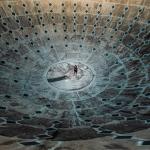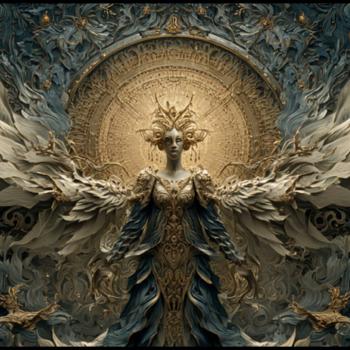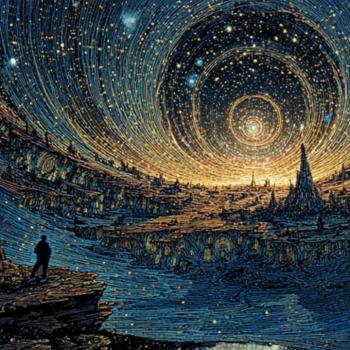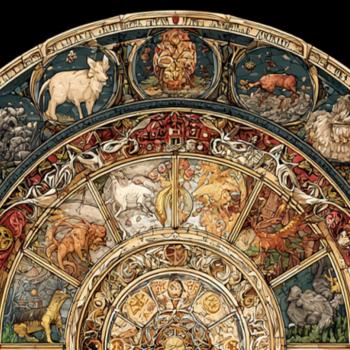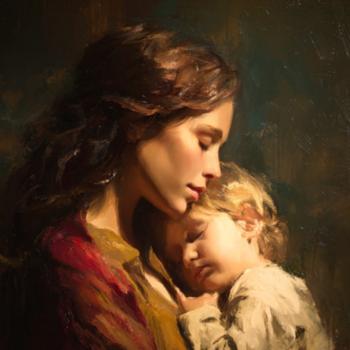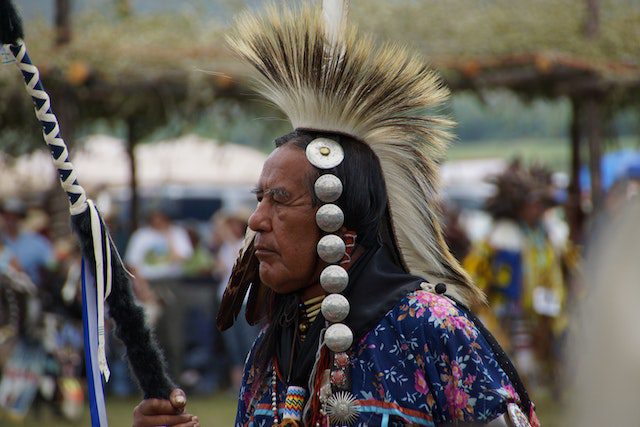
A few weeks ago I ran across this amazing book, quite by accident. I was perusing books at a local used bookstore and found this small paperback – American Indian Mythology by Alice Marriott and Carol K. Rachlin.
In the very first chapter, I read the first few pages of the Cheyenne Myth of Creation and it blew my mind.
Here, below, are a few excerpts from the Myth with my reactions and notes. I hope you’re sitting down.
HOW THE WORLD WAS CREATED – The Cheyenne Myth
“In the beginning, there was nothing, and Maheo, the All Spirit. lived in the void. He looked around him, but there was nothing to see. He listened, but there was nothing to hear. There was only Maheo, alone in nothingness.
Because of the greatness of his Power, Maheo was not lonesome. His being was a Universe. But as he moved through the endless time of nothingness, it seemed to Maheo that his Power should be put to use.
“What good is Power,” Maheo asked himself, “if it is not used to make a world and people to live in it?”
How can it be that the Cheyenne people and the Hebrew people both have such a similar story?
“In the beginning, there was nothing,” sounds exactly like a paraphrase from Genesis, chapter 1, verses 1-2:
“In the beginning, God created the heavens and the earth. Now the earth was formless and empty, darkness was over the surface of the deep, and the Spirit of God was hovering over the waters.”
Where the Cheyenne myth mentions Maheo and his Power as separate yet equal beings, Genesis mentions God and the Spirit of God in much the same way. Both God and Maheo speak as if to themselves but at the same time as if they are speaking to another who is like themselves.
The Cheyenne myth goes a bit further to say what later Christian theologians and philosophers would suggest: that God was not alone because God was “a Universe” unto Godself. In other words, God was complete in Godself and required or needed no one and nothing else, but decided to create because, as the Cheyenne myth phrases it, “What good is Power…if it is not used to make a world and people to live in it?”
From here there are deviations in the order and the manner in which God or Maheo creates the elements of light, water, air, and earth. But the similarities between the two myths do not end there.
Both Maheo and God agree that it is not good for man to be alone, for as Maheo says after creating the first man, “He is alone with the Grandmother Earth, as I was once alone with the voice…It is not good for anyone to be alone.”
So, Maheo’s desire to provide man with a companion stems from his own awareness of what it felt like to be alone, and although Maheo did not feel “lonesome” before he created all things, he knows that it is not good for man to endure that same aloneness.
As in the Genesis story, Maheo calls everything he creates “good”, but the way the Cheyenne myth communicates this is so beautiful:
“Light began to grow and spread, first white and bleached in the east, then golden and strong till it filled the middle of the sky and extended all around the horizon. Maheo watched the light. and he saw the birds and fishes. and the shellfish lying on the bottom of the lake as the light showed them to him. How beautiful it all is,” Maheo thought in his heart.”
We get to see, through Maheo’s eyes, the beauty of this creation and we get to hear his own inner thoughts and feelings about that beauty which go so much farther than merely saying that “He saw that it was good.”
It is this same love for his creation that compels Maheo to create the first human, as he gazes at the beauty of the Earth – which he refers to as “The Earth Woman” – and it says:
“Maheo looked at the Earth Woman and he thought she was very beautiful; the most beautiful thing he had made so far. She should not be alone, Maheo thought. Let me give her something to myself, so she will know that I am near her and that I love her.
“Maheo reached into his right side, and pulled out a rib bone. He breathed on the bone, and laid it softly on the bosom of the Earth Woman. The bone moved and stirred, stood upright and walked. The first man had come to be.”
Astonishingly, both Maheo and God create the first man but in the Cheyenne myth it is from Maheo’s own rib that Man is created.
We also see that Maheo’s great love for the Earth is what compels him to create Man so that she [the Earth] will not be alone and so that the Earth will “know that I am near her and that I love her.”
Man, in the Cheyenne myth, is a gift to the Earth and is intended to represent Maheo’s love for the Earth. Again, how much more beautiful than what we read in the Genesis account where Man is told to “have dominion over the Earth,” which has been translated today to mean that humanity is free to use and abuse Earth’s resources for our own pleasure and sustenance.
When Maheo sees that Man is alone, and realizes “…it is not good for anyone to be alone, (so) he fashioned a human woman from his own left rib and set her with the man. Then there were two persons on the Grandmother Earth, her children, and Maheo’s. They were happy together, and Maheo was happy as he watched them.”
Again, when Maheo comes to create the woman, he takes his own rib [not the Man’s rib] and creates her from himself.
Here, the implications are that both man and woman are each made directly from Maheo and they, together, form one complete image of Maheo when they come together.
The rest of the Cheyenne myth explains how Maheo creates by collaborating with the rest of his creation. They come to him and make requests based on what they need, and Maheo works together with all of them to provide air, water, and earth for them to thrive upon.
For example, when one of the birds flys to Maheo and makes a request for a place to land and build their nests, here is how Maheo responds:
“So be it,” answered Maheo, “but to make such a place I must have your help, all of you. By myself, I have made four things: the water, the light. the sky air, and the peoples of the water. Now I must have help if I am to create more, for my Power will only let me make four things by myself.”
“Tell us how we can help You,” said all the water peoples. “We are ready to do what You say.”
This great collaboration between Maheo and his creation teaches us that we must work together in harmony with one another, and with the Creator, to bring about good for everyone – not merely for ourselves.
And when Maheo sees his creation enjoying his gifts, he rejoices over them:
“How beautiful their wings are in the light,” Maheo said to his Power, as the birds wheeled and turned, and became living patterns against the sky.”
The Cheyenne myth ends with this beautiful reminder for all of us:
“Maheo is still with us. He is everywhere, watching all his people, and all the creation he has made. Maheo is all good and all life; he is the creator, the guardian, and the teacher.
We are all here because of Maheo.”
Doesn’t this sound similar to what the Apostle Paul says in Colossians 1:16-17
“For in Him all things were created, things in heaven and on earth, visible and invisible…All things were created through Him and for Him. He is before all things, and in Him all things hold together.”
And, of course, what John’s Gospel says in Chapter 1, verses 3-5:
“Through him all things were made; without him nothing was made that has been made. In him was life, and that life was the light of all mankind. The light shines in the darkness, and the darkness has not overcome it.”
The more I come across examples of underlying truth in scriptures, myths and stories like this, the more convinced I am that it is the same Spirit, the same Christ, the same Maheo, the same Buddha, the same Sophia, the same Truth, and Wisdom that permeates every such story, and every inspired scripture.
All of it is God-breathed. We just have to take a deep breath and receive it.
*The Cheyenne Creation Myth is quoted from the book AMERICAN INDIAN MYTHOLOGY by Alice Marriott and Carol K. Rachlin, pg. 37-43
**


